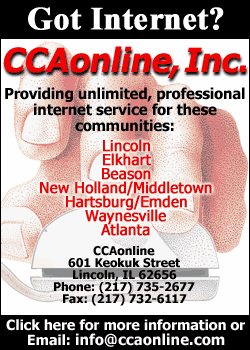|
Saturday,
Dec. 1 — Thomas Anthony Quinn; acoustic folk/rock guitar and
vocals
Friday,
Dec. 7 — Thomas Anthony Quinn; acoustic folk/rock guitar and
vocals
Saturday,
Dec. 8 — to be announced
Friday,
Dec. 14 — Eleanor Gunderman and Dr. John Raffa; piano and violin
Saturday,
Dec. 15 — Thomas Anthony Quinn; acoustic folk/rock guitar and
vocals
Friday,
Dec. 21 — Eleanor Gunderman; piano
Saturday,
Dec. 22 — Jason Yarcho and Allison Leonard; piano and vocals
Friday,
Dec. 28 — Jason Yarcho and Allison Leonard; piano and vocals
Saturday,
Dec. 29 — Jason Yarcho and Allison Leonard; piano and vocals
Monday,
Dec. 31 (New Year’s Eve) — Jason Yarcho, Allison Leonard, Thomas
Anthony Quinn and Kim Quinn; piano, acoustic guitar and vocals.
Dancing in the IC Room from 10 p.m. to 12:30 a.m.
Restaurant
hours: Tuesday-Saturday 11 a.m. to 9 p.m. (lounge stays open later);
Sunday 11 a.m. to 2 p.m.
|


|
|
As
more people rediscover the natural relationship between medicine and
healing, books on herbs and their healing powers are becoming
popular with the general public. "The New Healing Herbs"
is a revised edition of Michael Castleman’s 1991 standard on
consumer guidance to herbal medicines and their curative properties.
According
to Castleman, herbal medicine is now a $3-billion-a-year industry. A
recent survey indicated almost half of the adults in America —
more than 100 million people — had tried some kind of herbal
remedy. Even more significant is that "many of today’s herb
users are mainstream M.D.’s. A decade ago, the medical profession
was at best skeptical of herbal medicine. ... Doctors have become
more open to herbal medicine in part because family members,
friends, and patients have reported success with herbs."

One
result of this interest in herbs has been the development of
standardized extracts. Castleman explains that standardized herbal
extracts "are made from plants that have been bred to contain
certain concentrations of pharmacologically active compounds."
In other words, these plants have been developed under controlled
conditions to produce a reliable uniformity of dosage.
This
book is divided into six easy-to-use chapters.
"From
Magic to Medicine" is a brief history of herbal medicine
beginning with the Chinese herbalists of 5,000 years ago.
"Tempest
in a Teapot: Are Healing Herbs Safe?" is a straightforward
discussion on the safe use of herbs and the double standards under
which they are sometimes judged. This chapter is essential for
anyone considering the use of herbal remedies because it contains 14
recommendations on how to use herbs safely.
For
those who decide to try an herbal remedy, "Storing and
Preparing Healing Herbs" has directions for drying, powdering,
storing and preparing herbs for infusions (extracts from the flower,
leaf or stem), decoctions (extracts from roots and barks), tinctures
(alcohol rather than water-based), capsules, ointments, and
compresses.
"How
to Obtain Healing Herbs" explains the three best methods for
obtaining herbs: gathering, growing or purchasing.

[to top of second column in this
review]
|

The
majority of the book is devoted to the chapter on the 100 best
healing herbs. In choosing the premier medicinal herbs Castleman
made his selections by analyzing availability, usefulness, safety
and popularity. Each entry contains information on the herb’s
therapeutic uses, medicinal myths, prescription recommendations,
safety concerns, and growing and cultivation.
There
are many well-known herbs in the list — notables such as ginkgo,
lavender, sarsaparilla and witch hazel. It is the lesser-known but
equally valuable herbs that make this chapter so fascinating. Black
cohash, the "classic women’s herb," is a treatment for
PMS, menstrual cramps, menopausal complaints and high blood
pressure. Echinacca is used as an immunity booster; it also can be
used to treat infections, colds and flu, wounds, yeast infections
and in some forms of cancer therapies. Mullein is a "velvety
soother" for minor respiratory irritations (coughs, sore
throats), hemorrhoids and diarrhea. Scullcap is the all-American
tranquilizer and sedative that can combat the effects of insomnia
and anxiety.

The
final chapter, "Using the Healing Herbs," contains
alphabetic tables on physical conditions and their herbal remedies
(for example, small doses of licorice can be used for canker sores),
and the healing actions of herbs (sage can be used as an
antiperspirant).
Michael
Castleman’s revised edition of "The New Healing Herbs"
is an informative place to start for anyone investigating the use of
herbal remedies. An added bonus is the handy index that allows users
to search for information on a particular herb, ailment or medical
condition.
The
book has received critical acclaim and praise from several reputable
sources including Modern Maturity, Herb Quarterly, Utne Reader and
Natural Health. This praise of Castleman’s work is justified;
called by Library Journal "one of the nation’s top health
writers," he has won numerous awards for his journalistic
efforts.
"The
New Healing Herbs" is an essential guide for anyone interested
in the traditional use of herbs for medicinal purposes.
For
more information visit the library at 725 Pekin St. or call (217)
732-8878.
[Richard
Sumrall, Lincoln Public Library District]
|